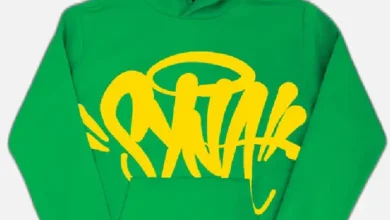The Rise of the Corteiz Tracksuit: A Streetwear Icon

A Movement in Motion: The Origins of Corteiz
In a world saturated with high-end streetwear labels, only a few have managed to spark genuine cultural resonance. Corteiz—often stylized as Crtz—is not just another logo slapped on a hoodie or a pair of sweatpants. It’s a movement, a statement, and a rebellion woven into fabric. Founded by the elusive Clint419, Corteiz didn’t start as a corporate-backed powerhouse. Instead, it blossomed from the underground, fueled by raw authenticity and an uncompromising vision. At the heart of the brand lies its now-iconic tracksuit—a two-piece symbol of urban cool, youthful defiance, and meticulously crafted streetwear.
The Corteiz tracksuit isn’t just clothing—it’s the uniform of the in-the-know, the badge of those who’ve kept their ears to the street and eyes off the mainstream. When it first began to circulate, it wasn’t in a typical launch with flashing cameras or celebrity endorsements. Instead, drops were announced cryptically, locations were revealed last-minute, and customers often had to literally chase the brand through city streets. This grassroots energy gave the tracksuit—and the entire brand—an unmatched cult-like following.
Design That Speaks Loud Without Saying a Word
There’s a quiet ferocity in the design language of Corteiz tracksuits. At a glance, they might seem like standard sportswear. But every seam, every patch, every subtle detail is intentional. From the bold Corteiz Alcatraz logo, symbolizing rebellion and freedom, to the often limited color palettes that range from stark monochromes to earthy tones, the design choices make a profound statement.
The fit is relaxed yet purposeful—neither too tight nor overly baggy. The jacket typically boasts a zip-up design with structured shoulders, high collars, and minimalist branding. The trousers match with tapered cuffs, zippered pockets, and comfort-focused elastic waists. What sets it apart, though, is not just aesthetics—it’s how it makes you feel. Putting on a Corteiz tracksuit is like stepping into a version of yourself that walks with purpose and presence.
Corteiz taps into the psychological power of uniformity—how a tracksuit can make a group of strangers feel like a brotherhood. When someone walks past wearing Crtz gear, there’s an unspoken acknowledgment—a shared code between those who get it.
Streetwear’s Shift: Why the Corteiz Tracksuit Matters Now
Streetwear has gone through numerous phases—from skate-inspired brands in the ’90s, to the luxury crossovers of the 2010s. But somewhere along the way, authenticity was lost. The Corteiz tracksuit represents a correction—a pivot back to streetwear’s core: community, struggle, and originality. It’s a reminder that style doesn’t always need to be dictated by high fashion runways or glossy lookbooks. Sometimes, the real runways are the bus stops, the stairwells, and the inner-city blocks.
This shift is critical. Corteiz doesn’t rely on traditional marketing. Its scarcity is part of its allure. If you’re wearing a Corteiz tracksuit, chances are you didn’t just walk into a store to buy it. You earned it—by following the drops, decoding the clues, and standing in line with others who share the same respect for the brand. That journey adds intrinsic value to the piece.
And it’s that experience—rooted in the hustle—that makes the Corteiz tracksuit more than a garment. It’s proof that fashion can still be thrilling, rebellious, and community-driven.
Crafted for the Culture, Worn by the Fearless
The Corteiz tracksuit isn’t meant to blend in. It’s crafted to command attention without screaming for it. It’s often sported by underground creatives, independent rappers, grime artists, and footballers off-duty—people who exist just outside the periphery of mainstream culture. They are trendsetters without trying to be.
The materials used in these tracksuits—premium cotton blends, breathable mesh linings, and reinforced stitching—suggest that the brand doesn’t compromise on quality. It’s not fast fashion; it’s built to last. That durability adds to its street appeal. Whether you’re skating, linking up in the city, or just lounging with the crew, the Corteiz tracksuit stands up to the wear and tear of real life.
But beyond physical function, it serves emotional armor. It empowers wearers to express identity without apology. The Corteiz customer isn’t looking for validation—they wear the tracksuit because it aligns with their personal ethos: fearless, original, and rooted in culture.
The Alcatraz Ethos: Rebellion in the Details
Perhaps no brand symbol is as conceptually brilliant as the Corteiz Alcatraz logo. It’s more than a visual—it’s an ideology. Alcatraz, the infamous prison off the coast of San Francisco, has long symbolized isolation and constraint. Corteiz flips that on its head, turning it into a symbol of breaking free from systems of control—whether those systems be fashion norms, societal expectations, or colonial ideologies.
This rebellion isn’t loud and obnoxious; it’s calculated and deliberate. Wearing the Corteiz tracksuit feels like participating in a modern-day protest. It’s anti-hype, anti-influencer, and completely uninterested in appealing to mass markets. And yet, ironically, that’s what makes it so desirable.
The tracksuit, therefore, becomes a vessel for deeper meanings. It’s for the youth who feel boxed in by the expectations of a system that doesn’t represent them. It’s for the dreamers, the runners, the misfits, and the builders of new worlds.
The Corteiz Drop Phenomenon: Scarcity Meets Strategy
One of the most fascinating aspects of Corteiz’s success—and particularly of the tracksuit—is its drop strategy. Where most brands chase exposure, Corteiz thrives on scarcity. It’s not uncommon for a Corteiz drop to sell out in minutes, with no warning and limited quantities. And unlike other labels that seek to expand endlessly, Corteiz deliberately keeps its operations tight, exclusive, and elusive.
This scarcity adds a sense of urgency and value to each release. The Corteiz tracksuit isn’t just bought—it’s hunted. Each piece feels like a trophy, not because it’s expensive, but because it’s rare and meaningful. This strategy creates an organic buzz, where word-of-mouth and online speculation do the heavy lifting that millions in advertising budgets can’t replicate.
In this way, the Corteiz tracksuit exists at the intersection of product and performance art. Every drop is a statement, and every piece worn becomes part of a larger narrative.
Corteiz in the Global Spotlight: From London to the World
While rooted in London’s multicultural pulse, the Corteiz movement has transcended borders. You’ll now see the tracksuit in Paris, New York, Lagos, and Tokyo. Its universal appeal lies in its defiance—it resonates with youth globally who are tired of playing by the rules. It’s become a global symbol of streetwear’s return to grit over gloss.
And yet, Corteiz doesn’t chase this global popularity—it earns it. Its founder Clint419 continues to stay grounded, often engaging with the community online and refusing to sell out to bigger brands. This resistance to corporate dilution keeps the brand, and especially the tracksuit, as a beacon of authenticity in an otherwise watered-down fashion ecosystem.
Final Stitch: The Legacy of the Corteiz Tracksuit
In the end, the Corteiz tracksuit is more than just a piece of clothing. It’s a manifesto stitched into cotton and polyester. It symbolizes a new era of streetwear—one that values culture over clout, quality over quantity, and authenticity over algorithm-driven hype.
Its legacy is already being etched not just in wardrobes, but in hearts. To wear Corteiz is to stand for something bigger than fashion. It’s to align with a movement that reminds us clothing can still carry meaning, rebellion, and soul.
So the next time you see someone in a Corteiz tracksuit, understand that what you’re witnessing isn’t just a trend—it’s history in motion.



